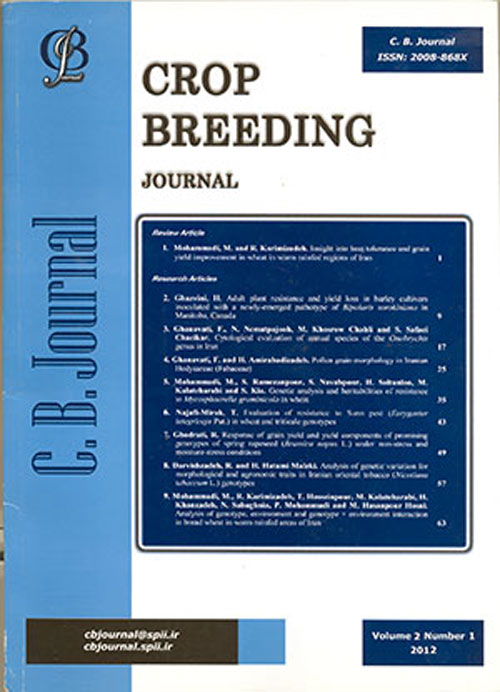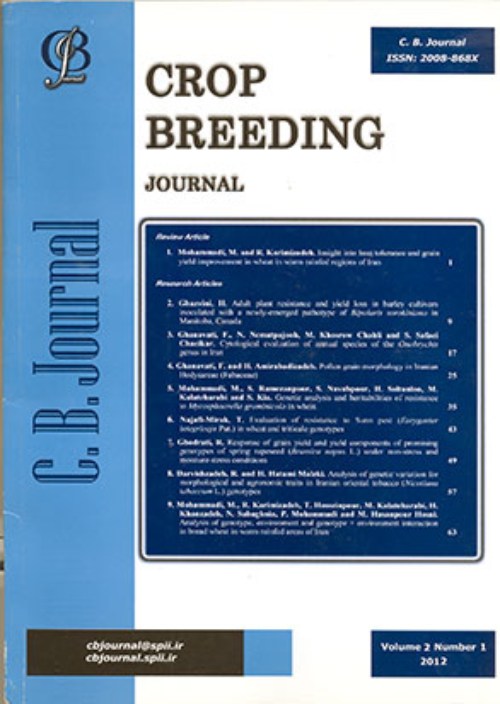فهرست مطالب

Crop Breeding Journal
Volume:7 Issue: 2, Summer-Autumn 2017
- تاریخ انتشار: 1396/01/25
- تعداد عناوین: 8
-
-
Pages 1-7Allelic variations at the Glu-1 and Glu-3 loci play an important role in determining dough visco-elastic properties and bread making quality. Fifty-nine bread wheat cultivars released in Iran since 1951 from four different agro-climate zones, were examined for their high (HMW-GS) and low-molecular-weight glutenin subunit (LMW-GS) composition, controlled at the Glu-1 and Glu-3 loci, respectively. In addition, the presence of the 1B.1R translocation was investigated. Three, eight, and four allelic variations were present at Glu-A1, Glu-B1, and Glu-D1 loci, respectively. Subunits 2*, 7, 7, and 2 are the dominant HMW-GS, at Glu-A1, Glu-B1, and Glu-D1, with frequencies of 45.8, 39, 25.4, and 59.3%, respectively. Five, eight and four allelic variations were present at the Glu-A3, Glu-B3 and Glu-D3 loci, with Glu-A3c, Glu-B3b and Glu-D3b LMW-GS dominating, with frequencies of 52.5, 39 and 59.3%, respectively. The frequencies of allelic variation at Glu-1 and Glu-3 differ greatly in different regions. Among the 59 cultivars/varieties examined in this study, four genotypes were local varieties (6.8%), 27 (45.8%) bred in the national breeding program and 28 (47.4%) originated from international nurseries. The average quality scores based on HMW-GS for local varieties, genotypes from the national breeding program and international nurseries were 5.5, 7.6 and 7.7 respectively. It was concluded that integration of desirable subunits at Glu-1 such as 1, 7, 5, must be used as the core focus of the breeding program, which could lead to the improvement of gluten quality in Iranian bread wheat cultivars.Keywords: Glutenin, allelic variation, SDS, PAGE, Triticum aestivum
-
Pages 9-14Allelic variations at the Glu-1 and Glu-3 loci play an important role in determining dough visco-elastic properties and bread making quality. Thirteen bread wheat cultivars released in Iran since 1930 from three different agro-climate zones adapted for dryland conditions, were examined for their high (HMW-GS) and low (LMW-GS) -molecular-weight glutenin subunits composition, controlled at the Glu-1 and Glu-3 loci, respectively. In addition, the presence of the 1B.1R translocation was investigated. Three, six, and two allelic variations were present at Glu-A1, Glu-B1, and Glu-D1 loci, respectively. Subunits 2*, 7, and 2 are the dominant HMW-GS, at Glu-A1, Glu-B1, and Glu-D1, with frequencies of 77, 46.2, and 54%, respectively. Four, five and five allelic variations were present at the Glu-A3, Glu-B3 and Glu-D3 loci, with Glu-A3e, Glu-B3i and Glu-D3b LMW-GS dominating, with frequencies of 46.2, 54 and 69.2%, respectively. The frequencies of allelic variation at Glu-1 and Glu-3 differ greatly in different regions. Among the 13 cultivars/varieties examined in this study, three genotypes were local varieties (23%), four (31%) were bred by Irans national breeding program, and six (46%) originated from international nurseries. The average quality scores based on HMW-GS for local varieties, genotypes from the national breeding program and international nurseries was the same with a score of 8. Research led to the conclusion that integrating desirable subunits at Glu-1 such as 1, 7, 5, should be the main focus of the countrys rainfed wheat breeding program, to achieve the goal of improving of gluten quality in Iranian bread wheat cultivars adapted to dryland conditions.Keywords: Glutenin, allelic variation, SDS, PAGE, Triticum aestivum
-
Pages 15-22Potato virus Y is known as the most important potato-infecting agent in many parts of the world. In this study, the genetic structure of 16 advanced potato clones that carry the alleles of Ry as an extreme resistance genewereinvestigated. Additionally, multiplex (duplex, triplex or quadruplex) state of genetic of selected clones, where the alleles originate from different species such as Solanum stoloniferum (4X), S. tuberosum subsp. andigena (4X), S. hougassi (6X), were evaluated using artificial mechanical and graft inoculations under greenhouse conditions. ELISA was used to confirm experimental materials infection. Results showed that potato clones designated as 96.353, 97.557, 97.559, 97.560, 98.433, 99.373, 99.384, 397097-2, 397082-10, 397074-9, 397081-1 and 396136-1 contain extreme resistance genes (ER) against PVYNTN.. These selected clones were crossed with a PVYNTN susceptible line, S440. At least 200 genotypes of each family were evaluated in three replications using mechanical infection with the PVYNTN. Chi square test was used to prove the fitness of observed segregation ratios in comparison to predicted ones. The results of X2 test showed that 99.373, 99.384 and 98.433 clones follow the duplex manner while 96.353, 97.560 and 97.559 were carrying the resistance gene in a simplex state. For 97.557, 397097-2, 397082-10, 397074-9, 397081-1 and 396136-1, there was a significant difference between the observed and expected ratios even for simplex, duplex or triplex stages. The identified duplex genotypes have the potential to provide a durable PVY genetic resistance and can decrease the virus titer in the harboring genotype.Keywords: hetero multiplex, potato, resistance
-
Pages 23-35Multi-environmental trials (METs) are essential to study genotype by environment interaction (GEI) for effective line (s) selection and cultivar recommendations in breeding programs. Twenty promising barley genotypes were studied across 12 environments in a randomized complete block design with three replications in six different warm and moderate sites in Iran across two cropping seasons (2014-2015 and 2015-2016) using the GGE-biplot method. The combined analysis of variance revealed that environment accounted for 49.3% of the total variation while G and GE-interaction (GEI) explained 4.4% and 25.1%, respectively. Three genotypes, G6, G8, and G18, were superior in terms of high performance and stability. The 12 test environments were grouped into three different mega-environments (Mega-1, 2 and 3). Genotypes G16, G20 and G9 were identified as the best winning genotypes in Mega-1, 2 and 3, respectively. Based on the GGE-biplot, genotype G3 was found to be the ideal genotype and environments (E8 and E9) were found to be the ideal environments. GGE-biplot provided a reasonable visual examination of the relationships among the test environments, the genotypes, and the GEI. Overall, genotype G3 was better than the other genotypes and is recommended for the warm sites of Iran.Keywords: Barley, GE interaction, GGE, biplot, Grain yield, Multi, environmental trials
-
Pages 37-47Stem rust, caused by Puccinia graminis f. sp. tritici, is a devastating wheat disease, which can cause serious grain yield reduction. Doubled haploid (DH) technique reduces the time required for the development of new varieties by up to almost five years. In this study, three F1 wheat hybrids including W1: Ghods*3/MV17, W2: Flanders/3*Ghods and W3: Hybrid de Bersee/3*Ghods along with three maize genotypes, H1: KSC 108, H2: SC 301 and H3: SC 704, along with a mixture of pollen grains of these three genotypes (H4) were used to generate DH lines. During DH lines production some characteristics, such as percentage of seed set, haploid embryo and haploid plantlets, were studied. In total, 150 DH lines resulting from all crosses, along with their parents and three check cultivars, Parsi, Mihan and Bolani, were evaluated for their infection type to Pgt races PTMNC, TTSTK and TTKSK. Results indicated that differences between check cultivars for coefficient of infection induced with race PTMNC at the adult plant stage was significant. Also, for infection type at the seedling stage, differences between check cultivars inoculated with race TTSTK were significant (PKeywords: wheat, Doubled haploid, Race, Stem rust
-
Pages 49-56This study was conducted to evaluate the physiological indices in relation to screening of rapeseed genotypes for drought tolerance, and to study seed yield and seed yield components under early and late season drought stress. Six rapeseed genotypes were evaluated under non-stressed and water deficit conditions during rosette and seed filling stages. The experiments were conducted in East Azarbaijan Agricultural and Natural Resources Research and Education Center, Iran for 2 years (2010-2011 and 2012-2013). According to the results, canopy temperature (Tc) was increased, stomatal conductance (Kl) and relative water content (RWC) were decreased significantly by drought stress during the rosette and seed filling stages. Correlations among the aforementioned physiological traits at seed filling stage with each other and with seed yield were significant. It seems that these physiological traits can reflect the drought effects in rapeseed genotypes. Among the genotypes, significant differences were observed for Kl at seed filling and RWC at rosette stages. While, Okapi and Licord having the highest seed yield, presented the highest Kl during seed filling and RWC at rosette stages. Therefore, Tc, Kl and RWC can be used to screen rapeseed genotypes for tolerance to drought stress. Drought stress during the seed filling stage significantly decreased plant height, the number of siliques per plant, 1,000-seeds weight and seed yield. Results of path analysis indicated that plant height and yield components indicated positive direct effect on seed yield. Plant height had the highest direct effects on seed yield. Among the genotypes, Okapi and Licord were more suitable for cultivation in normal and drought conditions.Keywords: Physiological index, Seed yield, Water deficit, Yield components
-
Pages 57-66Kavir wheat is one of the salinity tolerant cultivars that have been improved in Iran. In this research, F1, BC1, BC2 and F2 generations derived from a cross between Kavir × Arta and Kavir × Moghan3 (Arta and Moghan3 are susceptible to salinity) were evaluated through generation mean analysis in non-stress and salinity stress conditions in a randomized complete block design with three replications at the Agriculture Research Center of Kerman. The irrigation water salinity was 0.63 and 15 dS/m in non-stress and stress conditions, respectively. The salinity of farm soil was 2.1 dS/m in both conditions. The traits of flowering and maturity time, plant height, flag leaf relative water content, amount of Na and K in flag leaf, yield per plant and hundred seed weight were recorded for each treatment during the growth season and after harvest. The frequency distribution showed that Kavir was the superior parent in terms of the amount of Na while Arta and Moghan3 were the superior parent in terms of the amount of K and Kﳖ in non-stress conditions. The concentration of Na decreased and the concentration of K and Kﳖ increased in Kavir in stress conditions, while this condition was contrary in Arta and Moghan3. These results showed that when the plant encounters stress, some genes will be activated, which will result in a decrease in the concentration of Na and increase K uptake. Scale test results rejected the adequacy of the additive-dominance model and confirmed the presence of epistatic effects for these traits (except for Kﳖ in stress conditions) in both environments. None of these tests were significant for the Kﳖ in stress conditions. This result showed that the Kﳖ was affected by additive × additive gene effect and the adequacy of the three-parametric models in the joint scaling test also confirmed this.Keywords: wheat, SALINITY, tolerance, generation mean analysis
-
Pages 67-73Pomegranate is one of the most important horticultural crops in Iran. Fruit pomological characterization has usually been used for the assessment of pomegranate germplasm, and is a crucial step before the beginning of any molecular study. In spite of the commercial importance of Iranian pomegranate fruit worldwide, little information is available on the attributes of some of its genotypes. In this two-year study, 15 pomological attributes of 38 sour pomegranate genotypes growing in Markazi province were evaluated. A great variability was found among pomegranate genotypes in fruit weight and size, calyx size, 100 arils (g), total soluble solid contents, peel thickness, crack sensitivity, aril adhesion to the skin, aril colour, aril juiciness and seed hardiness. Some genotypes were notable for their various characteristics. For example,"6-3-S"genotypes with large fruit and good aril yield, red color, juicy aril, soft seeds, slight adhesion of the aril to the skin and low sensitivity to cracking is promising genotype for food processing and marketing. A greater part of variance was counted by traits such as calyx diameter, calyx length, fruit length, fruit weight and aril weight that showed wide variability among accessions and could be utilized for future breeding programs.Keywords: Pomegranate, Pomology, Fruit, IRAN


